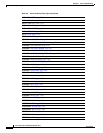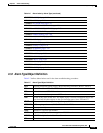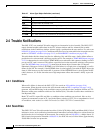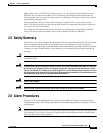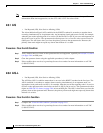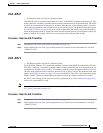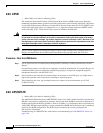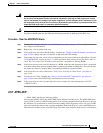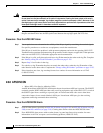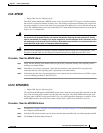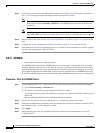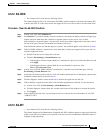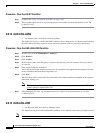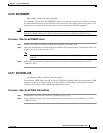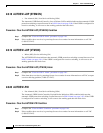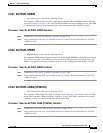
2-20
Cisco ONS 15327 Troubleshooting Guide, R3.4
March 2004
Chapter 2 Alarm Troubleshooting
Alarm Procedures
Warning
Invisible laser radiation might be emitted from the end of the unterminated fiber cable or connector.
Do not stare into the beam directly with optical instruments. Viewing the laser output with certain
optical instruments (for example, eye loupes, magnifiers, and microscopes) within a distance of 100
mm might pose an eye hazard. Use of controls or adjustments or performance of procedures other than
those specified might result in hazardous radiation exposure.
Caution Always use the supplied electrostatic discharge wristband when working with a powered ONS 15327.
Plug the wristband cable into the ESD jack located between the top high-speed and XTC slots.
Procedure: Clear the APSC-IMP Alarm
Step 1 Use an optical test set to determine the validity of the K byte signal by examining the received signal.
For specific procedures to use the test set equipment, consult the manufacturer.
If the K byte is invalid, the problem is with upstream equipment and not in the reporting ONS 15327.
Troubleshoot the upstream equipment using the procedures in this chapter, as applicable. If the upstream
nodes are not ONS 15327s, consult the appropriate user documentation.
Step 2 If the K byte is valid, verify that each node has a ring ID that matches the other node ring IDs. Complete
the “Identify a Ring ID or Node ID Number” procedure on page 2-125.
Step 3 Repeat Step 2 for all nodes in the ring.
Step 4 If a node has a ring ID number that does not match the other nodes, make the ring ID number of that
node identical to the other nodes. Complete the “Change a Ring ID Number” procedure on page 2-125.
Step 5 If the alarm does not clear, log onto http://www.cisco.com/tac for more information or call TAC
(1-800-553-2447).
2.6.8 APSCINCON
• Minor (MN), Non-Service Affecting (NSA)
An APS Inconsistent (APSCINCON) alarm means that an inconsistent APS byte is present. The SONET
overhead contains K1/K2 APS bytes that notify receiving equipment, such as the ONS 15327, to switch
the SONET signal from a working to a protect path. An inconsistent APS code occurs when three
consecutive frames do not contain identical APS bytes. Inconsistent APS bytes give the receiving
equipment conflicting commands about switching.
Procedure: Clear the APSCINCON Alarm
Step 1 Look for other alarms, especially an LOS (OC-N) alarm (see page 2-84), an LOF (OC-N) alarm (see page
2-80), or an AIS condition (see page 2-16). Clearing these alarms clears the APSCINCON alarm.
Step 2 If an APSINCON alarm occurs with no other alarms, log onto http://www.cisco.com/tac for more
information or call TAC to report a service-affecting problem (1-800-553-2447).



